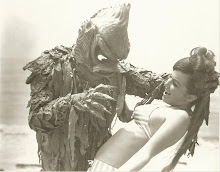We've finally arrived at the Top Ten Regional Horror Films of all time -- including the obvious picks, along with (I think) a few surprises. You can read more about all of the Top 100 (and 200 or so other regional horror/sci-fi flicks) in my new book from McFarland, which you can purchase here.
Happy Halloween!
10. Alice, Sweet Alice (New Jersey, 1976): This is not only one of my favorite horror films of all time, it's one of my favorite films of the 1970s, period. Brooke Shields debuts as a young girl murdered on the day of her first communion in Alfred Sole's creepy, near pitch-perfect giallo-style murder mystery. Everything about this film, from the art direction to the compositions to the incredibly painful and intimate violence, delivers. Even better are the unforgettable performances by Paula E. Sheppard as the disturbed older sister, Mildred Clinton's parish housekeeper, and Alphonse DeNoble as the grotesque landlord.
9. Friday the 13th (New Jersey, 1980): Could there have been a better way to open the 1980s for the genre? Well, maybe, but Sean S. Cunningham's brilliantly manipulative slasher film launched what would turn out to be an incredibly successful commercial period for the horror film (in fact, I think this may be the most financially successful regional horror film ever, but don't quote me on that). Yes, it copied John Carpenter's Halloween, but it also created its own set of clichés that other films quickly copied.
8. The Blob (Pennsylvania, 1958): Even though it was made in the wilds of Pennsylvania by religious filmmakers, The Blob remains one of the key films in the 1950s horror/sci-fi cycle, which was largely dominated by Hollywood-based films from major and minor studios alike. I imagine the presence of Steve McQueen, the fact that it was in color, and that snappy Burt Bacharach theme song helped a lot.
7. Christmas Evil (New Jersey, 1980): Like Alice, Sweet Alice, Lewis Jackson's low-key thriller about a Santa-obsessed toy factory employee who spends Christmas Eve rewarding the nice and violently punishing the naughty, isn't as well-known or well-regarded among fans as it ought to be. But it's an excellent example of exactly what a dedicated filmmaker with a low-budget can accomplish, and it's certainly the most well-crafted Christmas horror film ever made (at least so far).
6. The Legend of Boggy Creek (Arkansas, 1972): Charles B. Pierce made this pseudo-documentary about Arkansas Bigfoot legend The Fouke Monster with money from a local trucking company. He four-walled it across the south before selling it off to southern theater magnate Joy Houck, making millions in the process and launching a long and fairly successful career in low-budget horror and action films. No one who saw it, either during its theatrical run or on television, ever forgot it, and it influenced a decades-worth of sasquatch cinema.
5. Blood Feast (1963): Director Herschell Gordon Lewis has often referred to his inaugural gore film as being a bit like a Walt Whitman poem: it's no good, but it's the first of its kind, and so therefore it deserves a place. Exactly where that place is depends on your tastes, I guess. It was the first unabashed American gore film, and helped pave the way for more gratuitous onscreen bloodletting. It's also silly, cheap, offensive and ridiculous, which probably explains why it still has an audience all these years later.
4. Carnival of Souls (Kansas/Utah, 1962): Industrial filmmaker Herk Harvey made this little gem on a shoestring, and it gained a substantial reputation via late-night TV airings in subsequent years. Before Night of the Living Dead, Carnival paved the way for quirky, serious supernatural horror. Playing like an extended "Twilight Zone" episode, the film was unique in its day, and that surreal, ghoul-infested Saltair Pavilion sequence still packs a punch.
3. The Texas Chain Saw Massacre (Texas, 1974): Whatever you think of director Tobe Hooper's later work, his horror debut remains one of the most powerful genre films of the 1970s. Audiences at its premiere in San Francisco allegedly fled the theater vomiting, although I'm not sure why since (despite its garish title) it's fairly gore-free. A grim, unrelenting nightmare that makes the remake pale by comparison.
2. The Evil Dead (Tennessee/Michigan, 1981): The top five films on this list all changed the course of the horror genre in one way or another. Sam Raimi's initial feature (and its two sequels) broke new stylistic ground while the genre was mired in cookie-cutter slasher films, inspiring its own horde of cheap knock-offs and establishing a model for other enterprising young fans/filmmakers around the U.S.
1. Night of the Living Dead (Pennsylvania, 1968): More than any other film, George Romero's grim zombie opus launched a new era in for the horror genre, and its influence continues to be felt more than 40 years later. Most of the other films on this list (and most other post-1968 horror films) copied Night's realistic, modern setting, it's nihilistic tone, and in some cases outright aped its flesh-eating zombies. This was the birth of the zombie apocalypse, and of modern horror cinema.































